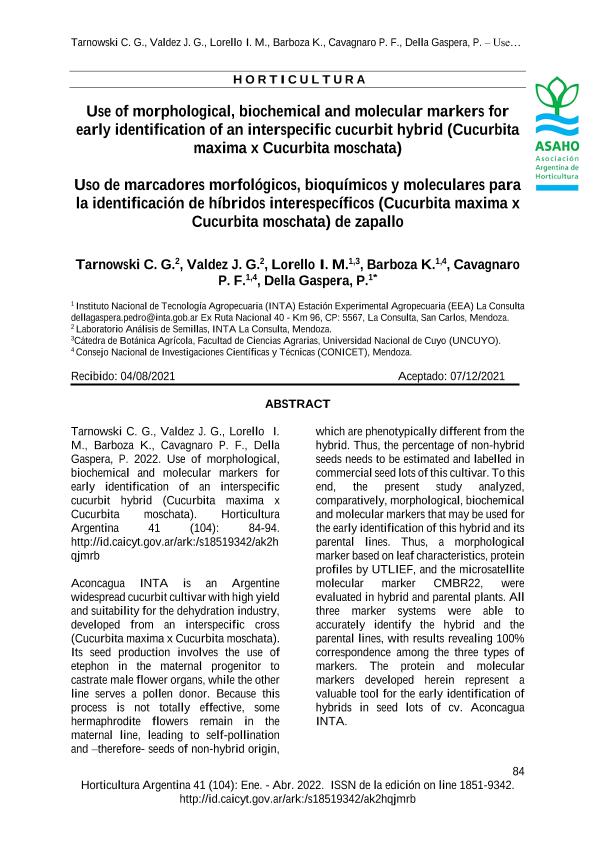Artículo
El cultivar de zapallo Aconcagua INTA es un hibrido interespecífico (Cucurbita maxima x Cucurbita moschata) de amplia difusión en el país y que posee excelentes rindes, buen color y aptitud para el deshidratado. La producción de semilla implica el cruzamiento entre ambas especies parentales, previo asperjado con etephon del parental femenino, con el objetivo de ?castrar? los órganos masculinos florales y obtener flores predominantemente femeninas. Debido a que siempre hay un porcentaje de flores que escapan a la castración química, los lotes de semilla incluyen un porcentaje de semillas no hibridas, provenientes de la autofecundación del parental materno. Estos individuos poseen fenotipo diferente al del cultivar, por lo que debe cuantificarse su presencia en los lotes de semilla. Con ese fin, en este trabajo se analizaron comparativamente marcadores morfológicos (basado en caracteres de la hoja), bioquímicos (análisis proteico por UTLIEF) y moleculares (con el marcador microsatélite CMBR22) para la identificación temprana del hibrido Aconcagua INTA y sus parentales. Los tres métodos permitieron identificar inequívocamente al hibrido y sus parentales, presentando correspondencia absoluta (100%) entre ellos, en las plantas analizadas. Los marcadores proteicos y moleculares permitirán la identificación temprana de híbridos de zapallo cv. Aconcagua. Aconcagua INTA is an Argentine widespread cucurbit cultivar with high yield and suitability for the dehydration industry, developed from an interspecific cross (Cucurbita maxima x Cucurbita moschata). Its seed production involves the use of etephon in the maternal progenitor to castrate male flower organs, while the other line serves a pollen donor. Because this process is not totally effective, some hermaphrodite flowers remain in the maternal line, leading to self-pollination and –therefore- seeds of non-hybrid origin, which are phenotypically different from the hybrid. Thus, the percentage of non-hybrid seeds needs to be estimated and labelled in commercial seed lots of this cultivar. To this end, the present study analyzed, comparatively, morphological, biochemical and molecular markers that may be used for the early identification of this hybrid and its parental lines. Thus, a morphological marker based on leaf characteristics, protein profiles by UTLIEF, and the microsatellite molecular marker CMBR22, were evaluated in hybrid and parental plants. All three marker systems were able to accurately identify the hybrid and the parental lines, with results revealing 100% correspondence among the three types of markers. The protein and molecular markers developed herein represent a valuable tool for the early identification of hybrids in seed lots of cv. Aconcagua INTA.
Uso de marcadores morfológicos, bioquímicos y moleculares para la identificación de híbridos interespecíficos (Cucurbita maxima x Cucurbita moschata) de zapallo
Título:
Use of morphological, biochemical and molecular markers for early identification of an interspecific cucurbit hybrid (Cucurbita maxima x Cucurbita moschata)
Tarnowski, C. G.; Valdez, Jorge Gustavo; Lorello, Inés María; Barboza Rojas, Karina ; Cavagnaro, Pablo Federico
; Cavagnaro, Pablo Federico ; Della Gaspera, Pedro Gustavo
; Della Gaspera, Pedro Gustavo
 ; Cavagnaro, Pablo Federico
; Cavagnaro, Pablo Federico ; Della Gaspera, Pedro Gustavo
; Della Gaspera, Pedro Gustavo
Fecha de publicación:
01/2022
Editorial:
Asociación Argentina de Horticultura
Revista:
Horticultura Argentina
ISSN:
0327-3431
e-ISSN:
1851-9342
Idioma:
Español
Tipo de recurso:
Artículo publicado
Clasificación temática:
Resumen
Palabras clave:
SEMILLAS
,
SELECCIÓN TEMPRANA
,
UTLIEF
,
MARCADOR MICROSATÉLITE
Archivos asociados
Licencia
Identificadores
Colecciones
Articulos(CCT - MENDOZA)
Articulos de CTRO.CIENTIFICO TECNOL.CONICET - MENDOZA
Articulos de CTRO.CIENTIFICO TECNOL.CONICET - MENDOZA
Citación
Tarnowski, C. G.; Valdez, Jorge Gustavo; Lorello, Inés María; Barboza Rojas, Karina; Cavagnaro, Pablo Federico; et al.; Uso de marcadores morfológicos, bioquímicos y moleculares para la identificación de híbridos interespecíficos (Cucurbita maxima x Cucurbita moschata) de zapallo; Asociación Argentina de Horticultura; Horticultura Argentina; 41; 1-2022; 84-94
Compartir



